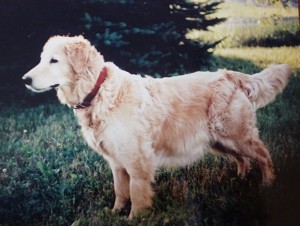(Click here to listen to an audio version of this blog!)
So where did dogs come from, and when did they begin to co-evolve with humans? These questions have been occupying the attention of a wide range of researchers around the world and have generated a large number of papers in some of our most prestigious scientific publications.
Genetically there is no doubt that dogs arose from wolves. Both gray wolves and dogs diverged from a common, wolf ancestor about 40,000 years ago. This is a significantly more distant split than we described in a blog four years ago (see Signs of Fall 11 (2016). The increased volume of ancient dog and wolf DNA that has been analyzed in these past four years has pushed the date of this divergence back 10,000 years!
The evolutionary lineage that would become dogs was, for the first 25,000 years of its existence, a wolf of unknown features or genetics. That unknown wolf, though, had to have some special characteristics that drew it to humans or, at least, made it less aggressive toward and less fearful of people.
About 15,000 years ago these pre-dog wolves began to associate with humans and started their co-evolutionary interactions. Exactly why this happened is not clear. The benefit to the pre-dog wolves is pretty obvious: food, shelter, protection from predators, etc., but what benefits did humans get from this new symbiosis?
One idea is that the pre-dog wolves simply began associating with humans in a very commensalistic way. The pre-dog wolves benefited from this new association but, at first anyway, the humans were not affected either in a positive or a negative way by the interaction. This model has the pre-dog wolves following wandering bands of hunter-gatherer humans and living on their offal and garbage and, possibly, the human corpses that warring bands of humans seem to regularly generate. It is hard to imagine in a late Ice Age world, though, that there would have been a large enough volume of refuse available to sustain even a tiny group of pre-dog wolves.
The pre-dog wolf’s appetite for refuse and waste (which any dog owner knows mirrors the predilections of most modern dogs very well!) may have brought the pre-dog wolf closer and closer to people. This closeness, then, might have led to a more active cost-benefit system that developed into the tight intertwining of the evolutionary fates of both the pre-dog wolf and humans.
What were the benefits to the people who took the pre-dog wolves in? Were these benefits substantial enough that the humans could sustainably give these pre-dog wolves a portion of their hard-won and probably quite limited food supplies as payment for their services? Did the services provided by dogs increase the fitness of their humans? Did the humans who associated with dogs have higher rates of ecological survival and success? Did these humans have higher levels of evolutionary fitness? Did the humans who had pre-dog wolf co-evolutionary partners out-compete those humans who did not?
Let’s look at several scientific papers published in the last six months and see what answers we can develop.
Modern dogs have many roles in human societies. They are protectors, they are alarm systems against intruders or dangers, they are hunting companions, they are livestock herders and they are beasts of burden. In the late Ice Age of 15,000 years ago, dogs may have especially taken on the job of transporting their humans and their possessions across the frozen waste. Dogs working to pull sleds, then, may have been one of the first functions that changed the human-dog symbiosis from commensalism to mutualism (a symbiosis where both species benefit). Dog-pulled sleds are faster and more versatile than human-pulled sleds. This human-dog symbiosis may have given the dog-utilizing group of humans a significant hunting and survival advantage over humans who did not have dog partners and also may have accelerated the spread of dogs among the dispersed human groups.
A paper published in Science last summer (June 26, 2020) compared DNA from the remains of a 9500 years old Greenland sled dog and the DNA from the remains of a 33,000 year old Siberian wolf to the growing DNA database of modern dogs from around the world. There were 35 authors of this paper from 12 different countries.
These researchers found that the DNA of the ancient Siberian wolf was similar to the DNA of the Greenland sled dogs, but that other sled dog breeds (like the Siberian husky and the Alaskan malamute) while sharing some genes with the Siberian wolf were not direct descendants of this wolf species. Instead, the DNA data indicates that these other sled dog breeds were descended from a common dog ancestor that existed about 12,000 years ago. This ancient ancestral dog, then, became widely distributed across the northern parts of the world and was developed into the various sled dog breeds we know today. A recent finding in Alaska of dog bones dating back 10,150 years that have distinct connections to ancient Siberian dogs supports this developing hypothesis.
The intensity and effectiveness of human-controlled breeding selection was a major point in Darwin’s book “Origin of Species.” Humans can act as powerful selecting forces and can accelerate and shape the evolution of animals and plants over which they have control. The genes that were selected for in the human-controlled breeding of Arctic sled dogs included genes observed in other Arctic-adapted species (like mammoths). Some of these genes control specific physiological functions like calcium transport and temperature sensitivity. Sled dogs also have a preponderance of genes that adapt them to low oxygen states (which occur during extended periods of stressful, physical exertion) and genes that enable them to digest and metabolize food rich in fats. Genetic adaptations to diets rich in polysaccharides (a feature seen in dogs being bred in developing agricultural societies in more temperate climates) are not seen in Arctic sled dog breeds.
Also, although interbreeding between dogs and wolves are known to occur in present times and very probably occurred throughout the 15,000 years of the pre-dog wolf and dog lineages, no modern wolf DNA was found in sled dog genomes. Speculation about this absence of wolf DNA centers around the impact of wolf characteristics on these specialized, working dogs. Any “wolf-ness” in a sled dog might make them unable to carry out their jobs resulting in either their rapid elimination from the dog population by the human breeder or by their own departure into the wild. At the very least, these “wolf-dogs” would not allowed to breed and pass along their genes to the continuing dog population.
What about the cost to the humans taking in the pre-dog wolves? Food was undoubtedly scarce in the late Ice Age. It is not logical that some of this vital resource would be shared without some immediate benefit. But, it is also logical that an association had to be made before a possible benefit could be derived.
An article in Scientific Reports this month (January 7, 2021) looks at the possible start of a human/pre-dog wolf association from a nutritional point of view. Humans during the Ice Age had to eat fats in order to have enough calories to maintain body heat and survive in the extreme cold of their environments. Speculation is that the absolute necessity for this high level of fat consumption was written into the genes of these early evolving humans and stays with many of us to this day to the great detriment of our body mass indices and arterial wall linings! Fatty foods, though, are irresistible and generate their own particular auras of craving and comfort.
In an hunter-gather group in the Ice Age, the humans would have preferentially eaten the fatty parts of their prey animals and possibly avoided the very lean portions in order to keep from ingesting excessive amounts of protein. Wolves, though, can flourish on a diet rich in lean meat. Possibly, the humans in this Ice Age system ate the fattiest parts of their kills and fed the less desirable, and potentially toxic, leaner portions to the close-by pre-dog wolves thus establishing an association that then grew into a more productive symbiosis.
Next week: more on where dogs came from and what they are!






